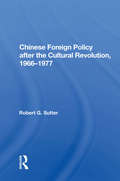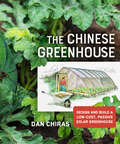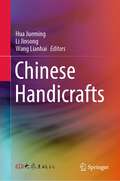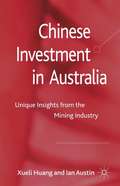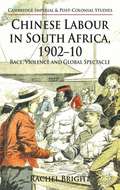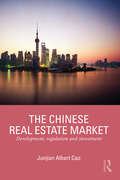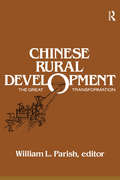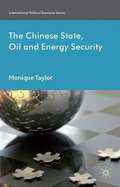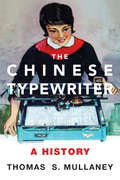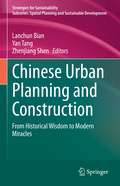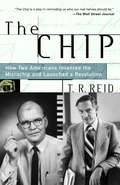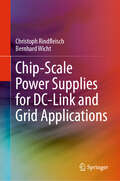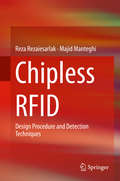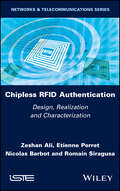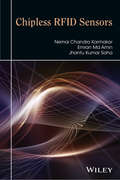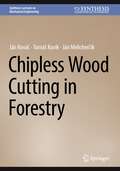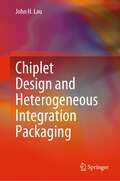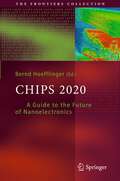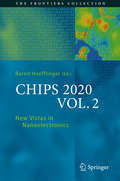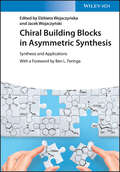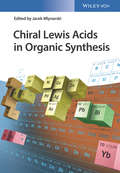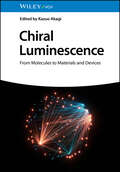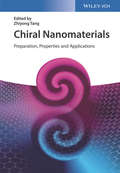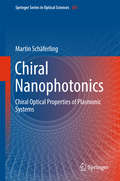- Table View
- List View
Chinese Foreign Policy/h
by Robert G. SutterChinese foreign policy has changed radically since the Cultural Revolution of 1966-1969. This book focuses on turning points in China's policy and looks at the influence of foreign pressures on China. It assesses the impact of internal political struggles on the conduct of Chinese foreign affairs.
The Chinese Greenhouse: Design and Build a Low-Cost, Passive Solar Greenhouse (Mother Earth News Books for Wiser Living)
by Dan Chiras“A prescription for survival in this gorgeously illustrated and accessible guide to the future of farming.” —Albert Bates, author of The Biochar SolutionGrow vegetables year-round in a greenhouse powered only by solar energy!Originally developed in China to feed millions, Chinese greenhouses are earth-sheltered, solar-heated, east-west oriented, intelligently glazed, and well-insulated. They have proven highly effective in growing warm-weather vegetables and fruits like green peppers and tomatoes in cold climates through fall, winter, and early spring using passive solar energy as the sole heat source.The Chinese Greenhouse is a full-color comprehensive guide to these passive solar greenhouses for self-sufficiency and growing year-round in soil or aquaponic grow beds with no additional heat. Coverage includes:How to design, build, and operate a Chinese greenhouseHow to improve performance via short-term and long-term heat bankingHow to provide additional heat to make your greenhouse operate even more effectivelyHow to cool the greenhouse during the summer.Become a more self-sufficient gardener, growing and harvesting a variety of fresh fruits and vegetables year-round, with your own Chinese greenhouse.“Wonderfully researched . . . brilliant.” —Jean-Martin Fortier, farmer and author of The Market Gardener, editor of Growers Magazine“Essential reading for pioneers of Chinese greenhouses.” —Pam Dawling, author of The Year-Round Hoophouse and Sustainable Market Farming“Every enthusiastic vegetable farmer dreams of this winter-growing miracle, and Dan shows how to do it.” —Shawna Coronado, author of 101 Organic Gardening Hacks
Chinese Handicrafts
by Hua Jueming Li Jinsong Wang LianhaiThis book systematically introduces readers to traditional Chinese handicrafts, which are original, distinct, and have had major impacts in China and around the globe. It explores 14 different types of handicraft, and provides a clear definition, detailed information on the techniques, and extensive discussion of each. Readers will not only learn the fascinating stories behind traditional Chinese handicrafts, but also be inspired by the great Chinese handicraftsmen’s inherent spirit of innovation and creativity.
Chinese Investment in Australia
by Xueli Huang Ian AustinAustralia is renowned for its abundance of natural resources and is one of the largest recipients of Chinese direct investment. State- and privately-owned Chinese firms have invested heavily in the Australian minerals industry to secure a supply for their domestic production. In this book, the authors provide a comprehensive review of how Chinese firms have successfully invested in the Australian mineral industry based on their extensive research and consulting experiences. They provide unique insights into the entry processes used by Chinese investors, factors contributing to their successes, lessons they have learnt, and the challenges they have encountered in managing their investment. Moreover, the book also elaborates on how the political, economic and competitive forces in both countries influence Chinese investments in Australia. It is an informative tool for domestic and international policy makers, business professionals, academic and informed readers with interests on how China's resource requirements are impacting the Australian political and commercial landscape.
Chinese Labour in South Africa, 1902-10
by Rachel K. BrightThis book explores the decision of the British Empire to import Chinese labour to southern Africa despite the already tense racial situation in the region. It enables a clearer understanding of racial and political developments in southern Africa during the reconstruction period and places localised issues within a wider historiography.
The Chinese Real Estate Market: Development, Regulation and Investment (Routledge International Real Estate Markets Series)
by Junjian Albert CaoThis is the first book to fully present, analyse and interpret the Chinese real estate market. Dr Junjian Albert Cao examines the Chinese real estate market’s growth trajectory, unique governance and factors affecting values and investment in the context of reforms, rapid economic growth and urbanization. The book provides essential insights into the institutional change surrounding the development of the property market, government intervention at local and national levels, taxes and other regulatory charges, and factors such as market practices, economic changes, government policies and social changes that affect the value of real estate. Furthermore, the book analyses academic and policy debates on issues such as: commercial property investment housing price inflation property rights protection affordable and social housing market practices and regulation environment and sustainability taxation property-led growth and the reliance of local economic growth on the property sector The book offers a comprehensive, in-depth and up-to-date account of the Chinese property market and presents a full assessment of the investment potential of Chinese real estate. It is a must read for students, academics and real estate professionals interested in this fascinating real estate market that has implications for Chinese and the world economies.
Chinese Rural Development: The Great Transformation
by William L. ParishThis text examines the Pacific War, the Korean War and the Vietnam War, from the perspective of those who fought the wars and lived through them. The relationship between history and memory informs the book, and each war is relocated in the historical and cultural experiences of Asian countries.
The Chinese State, Oil and Energy Security
by Monique TaylorMonique Taylor analyses the policy rationale and institutional underpinnings of China's state-led or neomercantilist oil strategy, and its development, set against the wider context of economic transformation as the country transitions from a centrally planned to market economy. The Chinese government's institutional capacities and policy instruments, namely the national oil companies (NOCs) and powerful central planning agencies, enable Beijing to pursue this state-led approach to energy security. Oil is a strategic sector in the Chinese economy and was never intended to 'grow out of the plan' and privatise, in contrast to the non-state sectors, due to its vital role in China's economic growth and development, and social stability. In tracing oil industry development in China from 1949 to the present day, an elite-driven account of institutional change is provided, showing that the party leadership has driven the reform process and remains the pivotal player in energy policymaking.
The Chinese Typewriter: A History (The\mit Press Ser.)
by Thomas S. MullaneyHow Chinese characters triumphed over the QWERTY keyboard and laid the foundation for China's information technology successes today.Chinese writing is character based, the one major world script that is neither alphabetic nor syllabic. Through the years, the Chinese written language encountered presumed alphabetic universalism in the form of Morse Code, Braille, stenography, Linotype, punch cards, word processing, and other systems developed with the Latin alphabet in mind. This book is about those encounters—in particular thousands of Chinese characters versus the typewriter and its QWERTY keyboard. Thomas Mullaney describes a fascinating series of experiments, prototypes, failures, and successes in the century-long quest for a workable Chinese typewriter. The earliest Chinese typewriters, Mullaney tells us, were figments of popular imagination, sensational accounts of twelve-foot keyboards with 5,000 keys. One of the first Chinese typewriters actually constructed was invented by a Christian missionary, who organized characters by common usage (but promoted the less-common characters for “Jesus" to the common usage level). Later came typewriters manufactured for use in Chinese offices, and typewriting schools that turned out trained “typewriter girls” and “typewriter boys.” Still later was the “Double Pigeon” typewriter produced by the Shanghai Calculator and Typewriter Factory, the typewriter of choice under Mao. Clerks and secretaries in this era experimented with alternative ways of organizing characters on their tray beds, inventing an input method that was the first instance of “predictive text.”Today, after more than a century of resistance against the alphabetic, not only have Chinese characters prevailed, they form the linguistic substrate of the vibrant world of Chinese information technology. The Chinese Typewriter, not just an “object history” but grappling with broad questions of technological change and global communication, shows how this happened.A Study of the Weatherhead East Asian InstituteColumbia University
Chinese Urban Planning and Construction: From Historical Wisdom to Modern Miracles (Strategies for Sustainability)
by Lanchun Bian Yan Tang Zhenjiang ShenThis volume introduces and discusses the achievements and mechanisms of urban planning and construction in China from multiple professional perspectives, covering practices and processes ranging from ancient times to the present day. The book has 14 chapters, each addressing a specific Chinese urban planning and construction topic with examples and applications in various cities and regions, and each providing an all-around analysis of Chinese urban development issues at different scales, including government administrations, planning progresses, urban investments, social impacts and construction models. The book provides a comprehensive overview of urban planning and construction in China, especially its successful experiences in the historical period and modern era, which will greatly benefit scholars and readers who are interested in China, as well as urban planners, architects and historians. The book is organized into 4 main parts. Part 1 focuses on "historical wisdom" to summarize ancient Chinese efforts to cope with nature and the environment. It interprets the unique wisdom of ancient Chinese cities related to regional design, water conservancy system, and urban districts. Part 2 presents the “transformation" of urban planning in China by learning from both the traditional value and western experiences based on several cases, such as the spatial development of Beijing and the Beijing-Tianjin-Hebei capital region, the preservation of Qingdao city, the urban community development and regeneration in Chongqing city. Part 3 explores the "green and eco-city" by looking towards the future, illustrating Chinese practices and efforts to build more sustainable cities, such as green and low-carbon city construction in Wuhan, healthy city planning and eco-cities construction in China. Part 4 prospects the “modern miracles” brought forth by technological innovation and economic growth, and introduces the newest planning trends in China, such as the E-commerce Taobao villages in China and the innovation districts in Beijing. It also explains the driving force of the "growth machine" of Suzhou city.
The Chip: How Two Americans Invented the Microchip and Launched a Revolution
by T. R. ReidBarely fifty years ago a computer was a gargantuan, vastly expensive thing that only a handful of scientists had ever seen. The world's brightest engineers were stymied in their quest to make these machines small and affordable until the solution finally came from two ingenious young Americans. Jack Kilby and Robert Noyce hit upon the stunning discovery that would make possible the silicon microchip, a work that would ultimately earn Kilby the Nobel Prize for physics in 2000. In this completely revised and updated edition of The Chip, T. R. Reid tells the gripping adventure story of their invention and of its growth into a global information industry. This is the story of how the digital age began.
Chip-Scale Power Supplies for DC-Link and Grid Applications
by Bernhard Wicht Christoph RindfleischThis book is a comprehensive single-source on the design of chip-scale high-voltage power supplies for low-power DC-link and grid applications. It is written in handbook style with systematic guidelines and includes implementation examples. The authors cover the full range, from technology fundamentals to circuit implementation details. The book includes guidelines for the application-specific selection of the converter topology, design guidelines for the inductive components, and a detailed description of low-power optimized control approaches and subcircuits. The authors also include guidelines for the selection and design of high-voltage on-chip power switches and for the reduction of parasitic effects such as capacitive losses.
Chipless RFID: Design Procedure and Detection Techniques
by Reza Rezaiesarlak Majid ManteghiThis book examines the design of chipless RFID systems. The authors begin with the philosophy of RFID and its effect on commercial applications. Then, they discuss the chipless RFID systems and the application of chipless RFID systems, the advantages it provides compared to conventional barcode ID and chipped RFID tags. The text then covers chipless RFID components in block diagram representation and introduce FCC requirements which should be considered in the design procedure of each component. The third chapter is dedicated to the complex natural resonance-based design of chipless RFID tags. The next chapter concerns about the detection techniques introduced for the identification of chipless RFID tags. The fifth chapter is dedicated to the localization and anti-collision techniques in chipless RFID systems. Final chapter is chipless RFID tags as sensors. It provides some applications where the tag can be used as both ID and sensor. The tag specifications and detection issues are addressed in this section.
Chipless RFID Authentication: Design, Realization and Characterization
by Zeshan Ali Etienne Perret Nicolas Barbot Romain SiragusaChipless RFID Authentication examines the development of highly secure product authentication systems for manufactured products by using chipless radio frequency identification (RFID) technology.The absence of a chip and its compatibility with mass production make chipless RFID an alternative to barcodes. This book discusses how, by using natural randomness inherent to the fabrication process, each chipless RFID tag has a unique signature that can never be reproduced, even if someone tries to copy the label.The book first explores the state-of-the-art of existing authentication and anti-counterfeiting methods based on their security level. Next, a methodology describing the characterization of chipless RFID tags for the authentication application is presented, followed by a discussion of the extraction of aspect-independent parameters for chipless RFID tags. After proposing designs for the tags, the book presents the realization and characterization of the labels (which exhibit naturally occurring randomness) for authentication, using printed circuit boards and inkjet printing on polyethylene terephthalate.
Chipless Rfid Sensors
by Nemai Chandra Karmakar Emran Amin Jhantu Kumar SahaA systematic treatment of the design and fabrication of chipless RFID sensors This book presents various sensing techniques incorporated into chipless RFID systems. The book is divided into five main sections: Introduction to Chipless RFID Sensors; RFID Sensor Design; Smart Materials; Fabrication, Integration and Testing; and Applications of Chipless RFID Sensors. After a comprehensive review of conventional RFID sensors, the book presents various passive microwave circuit designs to achieve compact, high data density and highly sensitive tag sensors for a number of real-world ubiquitous sensing applications. The book reviews the application of smart materials for microwave sensing and provides an overview of various micro- and nano-fabrication techniques with the potential to be used in the development of chipless RFID sensors. The authors also explore a chipless RFID reader design capable of reading data ID and sensory information from the chipless RFID sensors presented in the book. The unique features of the book are: Evaluating new chipless RFID sensor design that allow non-invasive PD detection and localization, real-time environment monitoring, and temperature threshold detection and humidity Providing a classification of smart materials based on sensing physical parameters (i. e. humidity, temperature, pH, gas, strain, light, etc. ) Discussing innovative micro- and nano-fabrication processes including printing suitable for chipless RFID sensors Presenting a detailed case study on various real-world applications including retail, pharmaceutical, logistics, power, and construction industries Chipless RFID Sensors is primarily written for researchers in the field of RF sensors but can serve as supplementary reading for graduate students and professors in electrical engineering and wireless communications.
Chipless Wood Cutting in Forestry (Synthesis Lectures on Mechanical Engineering)
by Ján Kováč Tomáš Kuvik Ján MelicherčíkThis scientific monograph presents the results obtained during research in the field of chipless logging and consists of two parts. At the beginning of the book, the current state of the researched task in chipless logging using chipless logging heads is presented. The experimental measurement methodology will be determined after reviewing the theoretical analysis of the cutting heads. The measurement methodology describes the principle of research carried out on an experimental hydraulic stand based on defined parameters. Data obtained during experimental measurement can be analyzed in many areas, e.g. statistical influence of individual factors as well as their combinations. The energy demand of chipless knives is also determined during experimental measurement.
Chiplet Design and Heterogeneous Integration Packaging
by John H. LauThe book focuses on the design, materials, process, fabrication, and reliability of chiplet design and heterogeneous integraton packaging. Both principles and engineering practice have been addressed, with more weight placed on engineering practice. This is achieved by providing in-depth study on a number of major topics such as chip partitioning, chip splitting, multiple system and heterogeneous integration with TSV-interposers, multiple system and heterogeneous integration with TSV-less interposers, chiplets lateral communication, system-in-package, fan-out wafer/panel-level packaging, and various Cu-Cu hybrid bonding. The book can benefit researchers, engineers, and graduate students in fields of electrical engineering, mechanical engineering, materials sciences, and industry engineering, etc.
Chips 2020: A Guide to the Future of Nanoelectronics (The Frontiers Collection)
by Bernd HoefflingerThe chips in present-day cell phones already contain billions of sub-100-nanometer transistors. By 2020, however, we will see systems-on-chips with trillions of 10-nanometer transistors. But this will be the end of the miniaturization, because yet smaller transistors, containing just a few control atoms, are subject to statistical fluctuations and thus no longer useful. We also need to worry about a potential energy crisis, because in less than five years from now, with current chip technology, the internet alone would consume the total global electrical power! This book presents a new, sustainable roadmap towards ultra-low-energy (femto-Joule), high-performance electronics. The focus is on the energy-efficiency of the various chip functions: sensing, processing, and communication, in a top-down spirit involving new architectures such as silicon brains, ultra-low-voltage circuits, energy harvesting, and 3D silicon technologies. Recognized world leaders from industry and from the research community share their views of this nanoelectronics future. They discuss, among other things, ubiquitous communication based on mobile companions, health and care supported by autonomous implants and by personal carebots, safe and efficient mobility assisted by co-pilots equipped with intelligent micro-electromechanical systems, and internet-based education for a billion people from kindergarden to retirement. This book should help and interest all those who will have to make decisions associated with future electronics: students, graduates, educators, and researchers, as well as managers, investors, and policy makers. Introduction: Towards Sustainable 2020 Nanoelectronics.- From Microelectronics to Nanoelectronics.- The Future of Eight Chip Technologies.- Analog-Digital Interfaces.- Interconnects and Transceivers.- Requirements and Markets for Nanoelectronics.- ITRS: The International Technology Roadmap for Semiconductors.- Nanolithography.- Power-Efficient Design Challenges.- Superprocessors and Supercomputers.- Towards Terabit Memories.- 3D Integration for Wireless Multimedia.- The Next-Generation Mobile User-Experience.- MEMS (Micro-Electro-Mechanical Systems) for Automotive and Consumer.- Vision Sensors and Cameras.- Digital Neural Networks for New Media.- Retinal Implants for Blind Patients.- Silicon Brains.- Energy Harvesting and Chip Autonomy.- The Energy Crisis.- The Extreme-Technology Industry.- Education and Research for the Age of Nanoelectronics.- 2020 World with Chips.
Chips 2020 Vol. 2: New Vistas in Nanoelectronics (The Frontiers Collection)
by Bernd HoefflingerThe release of this second volume of CHIPS 2020 coincides with the 50th anniversary of Moore's Law, a critical year marked by the end of the nanometer roadmap and by a significantly reduced annual rise in chip performance. At the same time, we are witnessing a data explosion in the Internet, which is consuming 40% more electrical power every year, leading to fears of a major blackout of the Internet by 2020. The messages of the first CHIPS 2020, published in 2012, concerned the realization of quantum steps for improving the energy efficiency of all chip functions. With this second volume, we review these messages and amplify upon the most promising directions: ultra-low-voltage electronics, nanoscale monolithic 3D integration, relevant-data, brain- and human-vision-inspired processing, and energy harvesting for chip autonomy. The team of authors, enlarged by more world leaders in low-power, monolithic 3D, video, and Silicon brains, presents new vistas in nanoelectronics, promising Moore-like exponential growth sustainable through to the 2030s.
Chiral Building Blocks in Asymmetric Synthesis: Synthesis and Applications
by Elżbieta Wojaczyńska Jacek WojaczyńskiChiral Building Blocks in Asymmetric Synthesis A comprehensive introduction to the important classes of chiral building blocks Chirality — the asymmetric quality found in certain chemical compounds — plays an essential role in our world: chiral compounds can be found in biology, pharmaceutical compounds, agrochemicals, and fragrances. The stereoselective preparation of these complex molecular constructions constitutes a challenge. To this end, modern asymmetric synthesis utilizes a variety of valuable and efficient reagents employed as chiral auxiliaries, metal complexes and organocatalysts in stereoselective catalysis, and enantiopure reactants termed as chiral building blocks. In Chiral Building Blocks in Asymmetric Synthesis, the achievements in the fields of preparation of and applications of chiral blocks are presented. In doing so, the book comprehensively discusses the important classes of these reactants as the key for the asymmetric synthesis of chiral molecules. As such, it is an indispensable resource about synthetic methods, as well as possible modifications and transformations of important classes of chiral compounds. It also highlights the importance of their use as reactants and auxiliaries in the preparation of more sophisticated molecules or supramolecular systems. In Chiral Building Blocks in Asymmetric Synthesis readers will also find: Organization according to the most important compound classes — e.g. amino acids, BINOL and its derivatives, terpenes, and others — with an emphasis on synthesis and application A focus on the use of chiral building blocks for the preparation of bioactive compounds and supramolecular assemblies Chiral Building Blocks in Asymmetric Synthesis is a useful reference for organic chemists, catalytic chemists, chemists in industry, medicinal chemists, pharmaceutical chemists, and the libraries that support them.
Chiral Environmental Pollutants: Analytical Methods, Environmental Implications and Toxicology
by Roland Kallenborn Heinrich Hühnerfuss Hassan Y. Aboul-Enein Imran AliThis monograph contains a survey on the role of chirality in ecotoxicological processes. The focus is on environmental trace analysis. Areas such as toxicology, ecotoxicology, synthetic chemistry, biology, and physics are also covered in detail in order to explain the different properties of enantiomers in environmental samples. This monograph delivers a comprehensive survey for environmental trace analysts, analytical chemists, ecotoxicologists, food scientists and experienced lab workers.
Chiral Lewis Acids in Organic Synthesis
by Jacek MlynarskiA complete overview covering the application of metal-based chiral Lewis acids from all parts of the periodic table, the Author emphasizes the most recent contributions to the field as well as prominent direction of development. The book discusses the design of chiral complexes as well as a wide spectrum of reactions promoted by various chiral Lewis acids, including water-compatible acids as well as the most important applications in the chemical and pharmaceutical industries. A must-have for catalytic and organic chemists working in the field, both in academia and industry, as well as pharmaceutical and medicinal chemists.
Chiral Luminescence: From Molecules to Materials and Devices
by Kazuo AkagiComprehensive resource illustrating the latest stage and development of chiral luminescence in science and technology, from fundamentals to applications Chiral Luminescence imparts a comprehensive understanding for chiral materials bearing circularly polarized luminescence (CPL) functions, including molecules, oligomers, polymers, chiral metal organic complexes, and chiral biochemical materials, with guidance on how to promote and control this kind of luminescence towards the development of advanced photonic materials and devices such as chiroptical and electronic devices, next-generation displays, and others. The book covers detailed information on the molecular design, synthesis, and polymerization methods of chiral luminescent materials, the evaluation of chiroptical properties represented by CPL, novel spectroscopic instruments and techniques, the fabrication of chiral luminescent devices such CPL-OLED, a theoretical evaluation, and potential applications. With insight from leading academics and industrial researchers in the field, Chiral Luminescence includes information on: Optical resolution and chiroptical properties of partially overlapping carbazolophanes and developments in CPL research using cyclodextrins Synthesis and chiroptical properties of helical, conjugated polymers and twisted molecules, and chiroptical and magnetooptical properties of porphyrin compounds Principles of CPL measurement systems and advances in measurement methods, and intense and sign-invertible CPL Development of organic light-emitting diodes using aggregation-induced enhanced CPL perylene diimides Binding constants as fundamental physical properties for quantitative treatments of sensing processes in supramolecular systems Providing far-reaching coverage of chiral luminescence and its many applications, Chiral Luminescence is a must-read resource for a variety of chemists and engineers who wish to understand the state-of-the-art development in this optical science.
Chiral Nanomaterials: Preparation, Properties and Applications
by Zhiyong TangThorough and up-to-date, this book presents recent developments in this exciting research field. To begin with, the text covers the fabrication of chiral nanomaterials via various synthesis methods, including electron beam lithography, ion beam etching, chemical synthesis and biological DNA directed assembly. This is followed by the relevant theory and reaction mechanisms, with a discussion of the characterization of chiral nanomaterials according to the optical properties of metal nanoparticles, semiconductor nanocrystals, and nanoclusters. The whole is rounded off by a summary of applications in the field of catalysis, sensors, and biomedicine. With its comprehensive yet concise coverage of the whole spectrum of research, this is invaluable reading for senior researchers and entrants to the field of nanoscience and materials science.
Chiral Nanophotonics: Chiral Optical Properties of Plasmonic Systems (Springer Series in Optical Sciences #205)
by Martin SchäferlingThis book describes the physics behind the optical properties of plasmonic nanostructures focusing on chiral aspects. It explains in detail how the geometry determines chiral near-fields and how to tailor their shape and strength. Electromagnetic fields with strong optical chirality interact strongly with chiral molecules and, therefore, can be used for enhancing the sensitivity of chiroptical spectroscopy techniques. Besides a short review of the latest results in the field of plasmonically enhanced enantiomer discrimination, this book introduces the concept of chiral plasmonic near-field sources for enhanced chiroptical spectroscopy. The discussion of the fundamental properties of these light sources provides the theoretical basis for further optimizations and is of interest for researchers at the intersection of nano-optics, plasmonics and stereochemistry.
